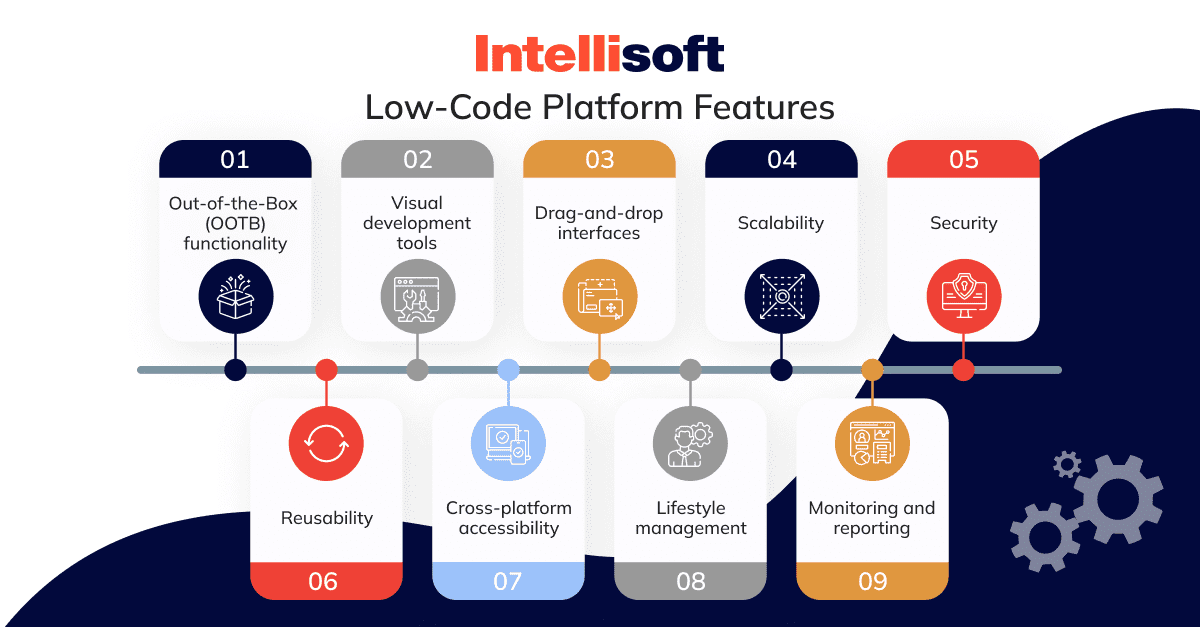Recommended Info For Choosing Low-Code Platform Recommendations
Recommended Info For Choosing Low-Code Platform Recommendations
Blog Article
Benefits Of Low Code Application Development In Relation To Integration Capabilities
Low-code development of applications offers huge advantages in the area of integration capabilities. These are vital for developing applications that are able to seamlessly connect to different platforms and services. Here are a few key advantages: Prebuilt Connectors and APIs
Wide Selection of Connectors. Low-code systems usually include a wide range of pre-built connections to enterprise systems that are popular (e.g. cloud services, databases and CRM). This makes it easier to integrate with systems.
API Integration: Many low-code platforms offer API integration options, which allow developers to connect to external services and data sources easily.
Simple to use:
Drag-and-Drop Integration: Integration tasks can often be accomplished using drag-and-drop interfaces, which makes it easy for both developers and non-developers to set up complicated integrations without writing a lot of code.
Visual Workflow Creators: These visual tools used to create workflows and data flows make users easier to comprehend the integration process.
Standardized Integration Methods:
SOAP and RESTful Services Support for standard web service protocols like SOAP and REST allows simple integration with a variety of external systems and applications.
OData Standards and other Standards Support for standards, such as OData provides the easy access of data and its manipulation across different platforms and applications.
Real-Time Data Synchronization:
Real-Time Integrations: Low-code systems can handle real-time data transfer between systems and applications. This makes sure that the information is current and consistent across the entire organization.
Event-Driven Architecture: A few platforms have support for event-driven architectures, permitting applications to respond to events in real time, which is vital for interactive and dynamic applications.
Legacy System Integration:
Interconnecting old Systems and new Systems Low-code platform often provides tools for integration with existing older systems. This allows organizations to modernize their IT Infrastructure without having to overhaul the existing systems.
Data Migration Tools Built in data-migration tools allow you to transfer data from older systems to low-code applications.
Integration of Third-Party Services:
Cloud Services: Seamless Integration with Cloud Services such as AWS Azure Google Cloud and Google Cloud allows for easy deployment of applications.
Business Applications Integration Lowcode platforms can be used to integrate different business applications including Salesforce, SAP, Microsoft Dynamics etc. and create a unified workflow among different business functions.
Simplified data management:
Unified Data Models: A few lowcode platforms have unification of coding models that simplify data management, integration and synchronization across various platforms.
Data Connectors Pre-configured data connectors allow you to easily access and alter data from many sources.
Security and Compliance:
Secure Integrations: Low-code platforms ensure that integrations conform to security protocols and standard security standards, securing data in transportation as well as during rest.
The platforms have features to make sure that the integrations are in compliance to regulatory regulations.
Extensibility:
Low-code platforms allow for the creation of custom scripts and programs to accommodate more complex integration needs. The flexibility offered without compromising the ease of use.
Plug-in Ecosystems. An ecosystem of plug-ins and extensions can allow you to enhance your integration abilities, adding additional functions as needed.
Overall, the capabilities for integration of low-code applications development platforms makes them an effective tool for creating connected, efficient and scalable applications. They can speed up the process for connecting disparate systems and enhance data flow. Companies can make use of existing technologies and adopt new ones while maintaining a cohesive IT environment. Have a look at the top rated web site on Low-code Platform for application development for site info including push notifications, app dev platform, application development platforms, develop web application, application modernization software, azure sql, rapid app development, low code platforms, driver jdbc, ms azure sql and more.
The Advantages Of Low-Code Development For Governance And Security
Low-code development of applications offers a variety of advantages when it comes to security and governance. These is essential to ensure that the application is compliant and secure. They also ensure that they are well-managed throughout their entire life cycle. These are the primary advantages.
Unified Management Console: This low-code platform usually provides a central dashboard for administrators to control and monitor all applications and ensure that the governance is consistent across the entire organization.
Role-Based Access Control RBAC : These platforms typically include roles-based access controls, which enable administrators to create and enforce rules. This allows only authorized users to alter or access specific parts of a program.
Compliance and Regulatory Adherence
Built-in Compliance Features: Many low-code platforms are designed to be compliant with the industry norms and regulations (e.g., GDPR, HIPAA). They provide tools and templates to ensure that the applications are compliant with these regulations.
Audit trails and logs Complete audit trails and logging can be integrated. This allows organizations to monitor and track access and changes, as well as ensure the compliance of internal policies as well as external regulations.
Increased Security Measures
Data Encryption: Low-code systems typically provide built-in encryption for data at rest and while in transit, making sure that data sensitive information is secured.
Security Certifications: A lot of providers of low-code software have security certifications, such as ISO 27001 or SOC 2 which prove that they follow strict standards. These certifications provide additional assurances to users.
Automated security updates:
Regular updates and patches Low code platforms are typically able to handle security updates and patches on a regular basis. This means that apps remain safe from the latest threats without the need for developers to manually handle.
Security Monitoring: Tools to conduct constant security monitoring are available. They send real-time alerts as well as information about security concerns that could arise.
Data Governance
Data Access Policies These platforms allow organisations to create data access policies and enforce the policies, making sure that data is available only to authorized users. They also ensure that the data is used correctly.
Data Masking and Anonymization Tools built in to mask and anonymize data safeguard sensitive data, particularly in testing and development environments.
Consistent Lifecycle Management of Applications:
Pipelines for deployment and development Low-code platforms provide integrated development and deploy pipelines which contain security checks. They ensure security is maintained throughout the entire lifecycle of the application.
Version Control: Integrated version control helps manage modifications and makes sure that modification to the application will be monitored and reversed if needed while ensuring the integrity of the application.
User Authentication Authorization
Single Sign On (SSO) Single Sign On (SSO): Supporting single sign-on and other advanced authentication methods reduces the burden of managing users and increases security.
Multi-Factor Authentication Most platforms come with built-in multi-factor support, adding an extra layer of security when accessing apps.
Policy Enforcement and Compliance:
Low-code platforms are usually pre-defined with policy templates to assist organizations in implementing security and governance policies quickly.
Tools for Monitoring Compliance They provide constant monitoring and reports about compliance levels, making it easier to recognize and resolve any issues that could arise.
Integration with Existing Security Infrastructure
Seamless Integration: Platforms that use low-code technology are built to integrate seamlessly with the existing tools and infrastructure like SIEM (Security Information and Event Management solutions) and firewalls.
API Security: API features that protect data and maintain application integrity are built into the API.
Training and Best Practices:
Guided best practices: Many platforms include guidelines and recommended practices for the development of secure applications. They assist non-developers in meeting security standards.
Some lowcode providers provide tools and security education for users to help them understand how to build and maintain a secure application.
The governance and security features of low-code applications make sure that they are built and managed in a regulated and compliant way. These platforms offer the tools and frameworks necessary to protect sensitive data and enforce policies. They also maintain regulatory compliance, all while simplifying administration and supervision of the development process. Read the most popular Enterprise application development with Low-code Platform for more tips including multiplatform mobile app development, rapid app development, cross platform app development, jdbc server, low code development platforms, low code development platforms, app modernization, database in azure, mobile development platforms, low code development platforms and more.
Benefits Of Low-Code App Development With Respect To Limitations And Customization
The low-code approach offers an unbiased method that permits significant customization and addresses weaknesses. The main advantages are: Limitations:
In overcoming Complexity Barriers:
Simplified Development: Low-code platform simplifies development by providing components and templates that are pre-built, allowing to speed up creation and deployment.
Guided Workflows: A lot of platforms provide guided workflows and wizards that help developers navigate through complex processes, reducing the likelihood of errors and guaranteeing consistency.
Scalability Solutions
Built-In Scalability: Low-code platforms often include features that support the development of scalable architectures, which allows applications to take on more load without significant redevelopment.
Performance Monitoring: Integrated performance monitoring tools and optimization make sure that applications are as efficient as possible, regardless of the size of their application.
Security and compliance
Integrated security features: Low-code platforms have security measures such as encryption and access control based on role and automated compliance checks, which address common security concerns.
Platforms are continuously updating their security protocols and measures of compliance, which ensures that applications remain safe against emerging threats.
Customization Features:
Extensibility:
Low-code platforms allow custom code They allow the integration and usage of custom code.
Custom Modules and plugins: Developers have the option to create customized modules or plugins to tailor specific functions to meet the specific requirements of a particular business.
APIs and Integration
API Support: A comprehensive support for APIs facilitates seamless integration with other systems and services, allowing for extensive customization and connectivity.
Third-Party Applications Lowcode platforms are usually pre-built with connectors for third-party applications. This makes it simpler to integrate them and customize the application.
Flexible UX/UI Designs:
Customizable User Interfaces: Developers have the ability to alter and create user interfaces to meet specific branding and usability requirements and provide a customized user experience.
Responsive Designs: The applications can be tailored to fit different screen sizes and devices.
Custom Business Logic for Businesses:
Visual Workflow Designers: These visual tools are used to customize and create workflows and business logic, allowing developers to create complex tailored processes.
Conditional Logic & scripting: Platforms allow for the application of conditional logic and scripting that is custom-made to handle specific business rules.
Data Management
Custom Data Modeling: Designers develop custom models to meet specific requirements for the particular application. They can tailor the handling of data to meet business specifications.
Advanced Data Processing: Integration of advanced data processing capabilities and tools allows customizations in the method of analyzing data within an application.
Balance Customization and Limitations:
Frameworks and Standards:
Low-code platforms encourage industry best Practices and Standards: Low code platforms encourage adhering to the industry's best standards and practices. This helps to maintain top-quality, secure, and flexible applications.
Governance Frameworks built-in governance frameworks guarantee that the customizations don't affect the security, integrity, or compliance of the application.
Iterative Development:
Rapid prototyping: The capacity to rapidly prototype and test changes allows developers to iterate based on user feedback, refining the application to meet the needs of users.
Low-code platforms enable constant improvement through ongoing customization and enhancing as requirements for business change.
User Empowerment
Giving Citizen Developers the tools they need In allowing non-developers customize their applications using intuitive user interfaces, platforms that do not require code broaden the number of users who can enhance and tailor applications.
Training and Support: Many platforms offer a wealth of training and support that can assist users to make effective modifications, without compromising application stability or performance.
Overall, low-code application development provides a solid framework to overcome limitations as well as a wealth of opportunities for customization. This balance allows businesses to develop and maintain functional applications that are tailored to their specific needs, while ensuring high standards of quality, security, and the ability to scale.